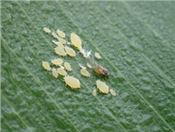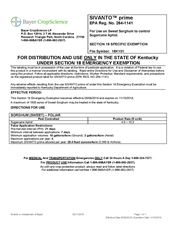Sugarcane Aphid Found On Sorghum In Kentucky
NATHAN MERCER AND DR. RIC BESSINNathan
LEXINGTON, KY.
Last week, the first sugarcane aphids (SCA) of the year for Kentucky were found in Woodford County on sweet sorghum. While only 5 percent of the leaves in the field were infested, some had over 700 SCA, meaning SCA has likely been in Kentucky for at least 2 weeks. SCA cannot survive winters north of southern Texas and must re-colonize Kentucky each year. SCA can be identified by their black tail pipes and antenna (Figure 1). On grain, forage, and sweet sorghum, SCA has the ability to be very destructive, potentially causing 100 percent crop loss.
Growers should begin scouting their sorghum weekly by searching the undersides of 40 leaves between knee and chest height in a field. If SCA is found, scouting should be done twice a week as SCA can reproduce rapidly. If over 25 percent of those leaves have 50 or more aphids, it is recommended that management action be taken. Preventive insecticide sprays are not recommended as SCA infestations do not always reach damaging levels.
A Section 18 Emergency Exemption was granted by the Environmental Protection Agency (EPA) in May to use Sivanto Prime for management of SCA on sweet sorghum in Kentucky. In order to use Sivanto Prime in sweet sorghum you must:
• Have a copy of the Section 18 label in your possession. (Figure 2)
• Be a certified applicator (private or commercial).
• Report the acreage and volume sprayed to Ric Bessin (rbessin@uky.edu) or the Kentucky Department of Agriculture (web@ky.gov). This reporting is to ensure that Kentucky will be eligible to obtain the emergency exemption from the EPA in the future.
Sivanto Prime is already labeled for use on grain and forage sorghum and can be sprayed in accordance with the label.
Producers may use Sivanto Prime on grain, forage, and sweet sorghum up to four times a year at a lower rate of 4 fluid ounces per acre and an upper limit of 10.5 fluid ounces per acre. Growers cannot apply more than 28 fluid ounces per acre per year and must have at least 7 days between applications and 21 days from application to harvest. ∆
NATHAN MERCER: Entomology Laboratory Technician, University of Kentucky
DR. RIC BESSIN: Extension Entomologist, University of Kentucky

Figure 1. Sugarcane aphid adults, nymphs and winged adults.
Photo: Ric Bessin, UK

Figure 2. Section 18 Emergency Exemption label required for using Sivanto Prime in sweet sorghum.